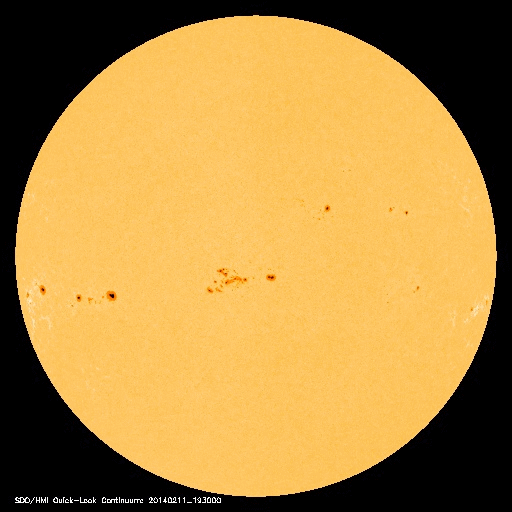Daily Suspicious0bserver's Weather Post:
February 14, 2014
What's in the sky tonight?
February 14, 2014
-Full Moon (exactly full at 6:53 p.m. EST). Look for Regulus in Leo to the Moon's left during evening, as shown here. A February full Moon is never far from Regulus.
-Algol in Perseus should be at its minimum light, magnitude 3.4 instead of its usual 2.1, for a couple hours centered on about 10:30 p.m. EST (7:30 p.m. PST). Algol takes several additional hours to fade and to rebrighten.
 News Posted Today:
February 14, 2014
News Posted Today:
February 14, 2014
Unveiling Ganymede
 Astro Picture of the Day:
February 14, 2014
Source:
Astro Picture of the Day:
February 14, 2014
Source:
Sprawling across almost 200 light-years, emission nebula IC 1805 is a mix of glowing interstellar gas and dark dust clouds about 7,500 light-years away in the Perseus spiral arm of our galaxy. Stars were born in this region whose nickname, the Heart Nebula, derives from its Valentine's-Day-appropriate shape. The clouds themselves are shaped by stellar winds and radiation from massive hot stars in the nebula's newborn star cluster Melotte 15 about 1.5 million years young. This deep telescopic image maps the pervasive light of narrow emission lines from atoms in the nebula to a color palette made popular in Hubble images of star forming regions. The field of view spans about two degrees on the sky or four times the diameter of a full moon. The cosmic heart is found in the constellation of Cassiopeia, the boastful mythical Queen of Aethiopia.
Daily Suspicious0bserver's Weather Post:
February 15, 2014
What's in the sky tonight?
February 15, 2014
-This is the time of year when, soon after dark, skywatchers at mid-northern latitudes see bright Capella crossing near the zenith and Orion standing highest in the south. Orion's diagonal belt points lower left toward bright Sirius, and upper right more or less toward Aldebaran. Beyond Aldebaran lie the Pleiades.

 Astro Picture of the Day:
February 15, 2014
Source:
Astro Picture of the Day:
February 15, 2014
Source:
This helmet-shaped cosmic cloud with wing-like appendages is popularly called Thor's Helmet. Heroically sized even for a Norse god, Thor's Helmet is about 30 light-years across. In fact, the helmet is more like an interstellar bubble, blown as a fast wind from the bright, massive star near the bubble's center sweeps through a surrounding molecular cloud. Known as a Wolf-Rayet star, the central star is an extremely hot giant thought to be in a brief, pre-supernova stage of evolution. Cataloged as NGC 2359, the nebula is located about 15,000 light-years away in the constellation Canis Major. The sharp image, made using broadband and narrowband filters, captures striking details of the nebula's filamentary structures. It shows off a blue-green color from strong emission due to oxygen atoms in the glowing gas.